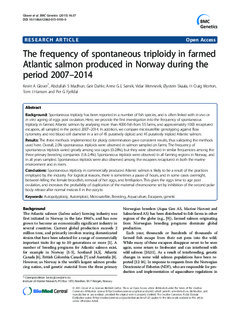| dc.description.abstract | Background:
Spontaneous triploidy has been reported in a number of fish species, and is often linked with in vivo or in vitro ageing of eggs post ovulation. Here, we provide the first investigation into the frequency of spontaneous triploidy in farmed Atlantic salmon by analysing more than 4000 fish from 55 farms, and approximately 1000 recaptured escapees, all sampled in the period 2007–2014. In addition, we compare microsatellite genotyping against flow cytometry and red blood cell diameter in a set of 45 putatively diploid and 45 putatively triploid Atlantic salmon.
Results:
The three methods implemented for ploidy determination gave consistent results, thus validating the methods used here. Overall, 2.0% spontaneous triploids were observed in salmon sampled on farms. The frequency of spontaneous triploids varied greatly among sea cages (0-28%), but they were observed in similar frequencies among the three primary breeding companies (1.8-2.4%). Spontaneous triploids were observed in all farming regions in Norway, and in all years sampled. Spontaneous triploids were also observed among the escapees recaptured in both the marine environment and in rivers.
Conclusions:
Spontaneous triploidy in commercially produced Atlantic salmon is likely to be a result of the practices employed by the industry. For logistical reasons, there is sometimes a pause of hours, and in some cases overnight, between killing the female broodfish, removal of her eggs, and fertilization. This gives the eggs time to age post ovulation, and increases the probability of duplication of the maternal chromosome set by inhibition of the second polar body release after normal meiosis II in the oocyte. | nb_NO |

